Module 6 Around town知识归纳与练习
文档属性
| 名称 | Module 6 Around town知识归纳与练习 | 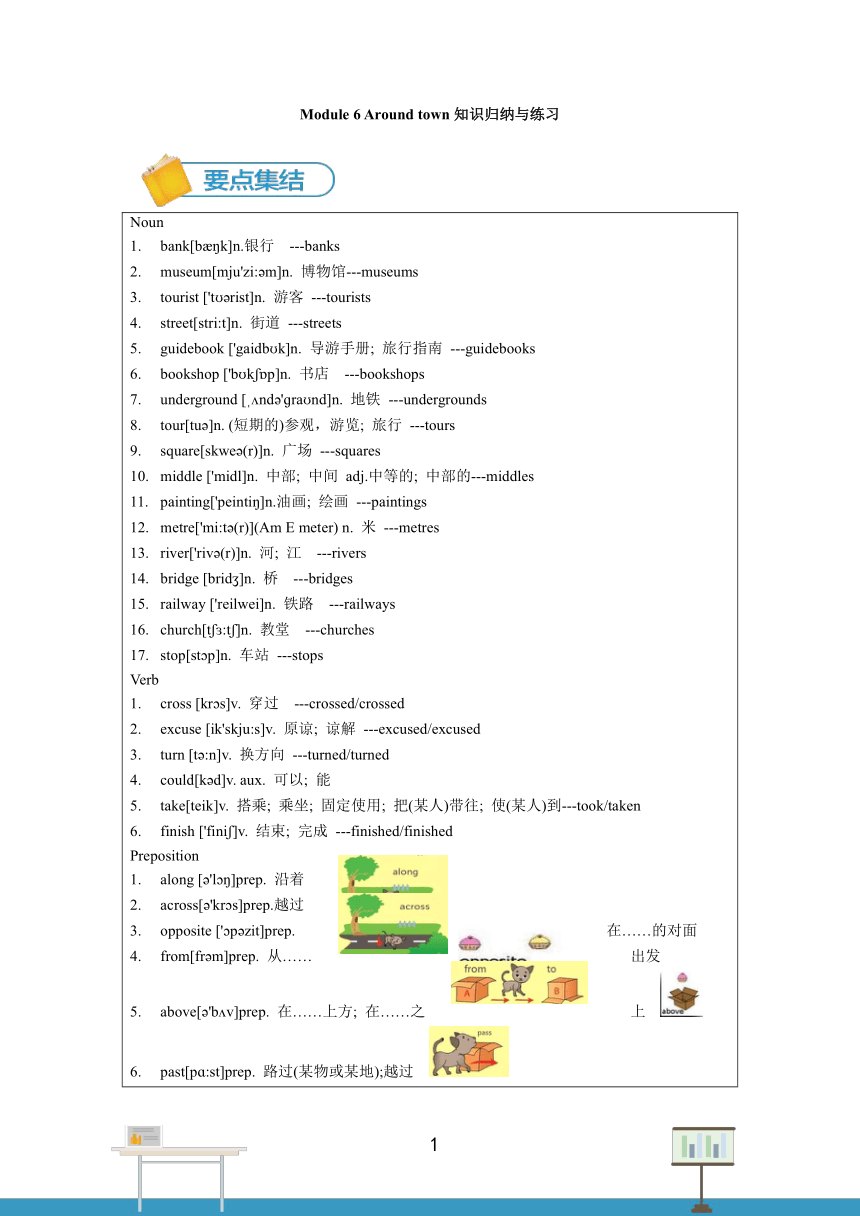 | |
| 格式 | doc | ||
| 文件大小 | 412.7KB | ||
| 资源类型 | 教案 | ||
| 版本资源 | 外研版 | ||
| 科目 | 英语 | ||
| 更新时间 | 2022-02-15 17:20:55 | ||
图片预览

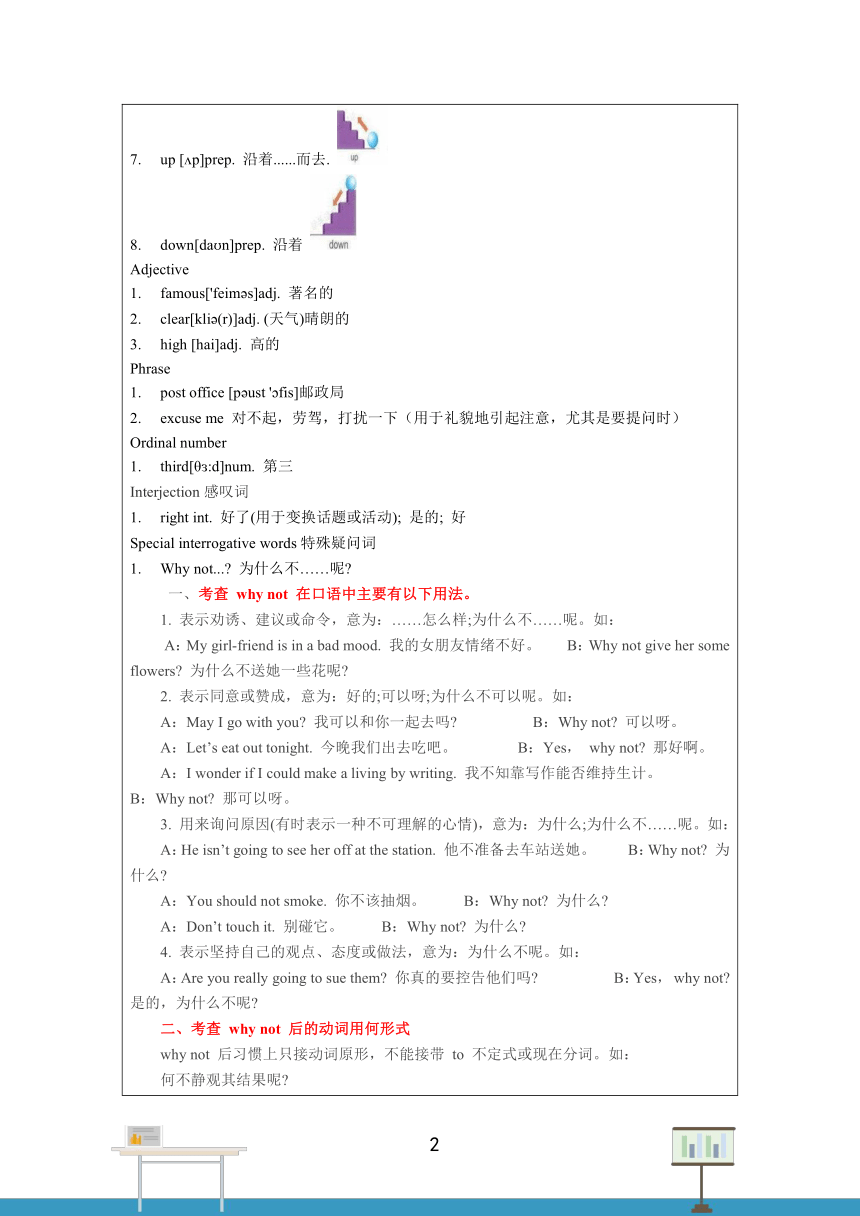
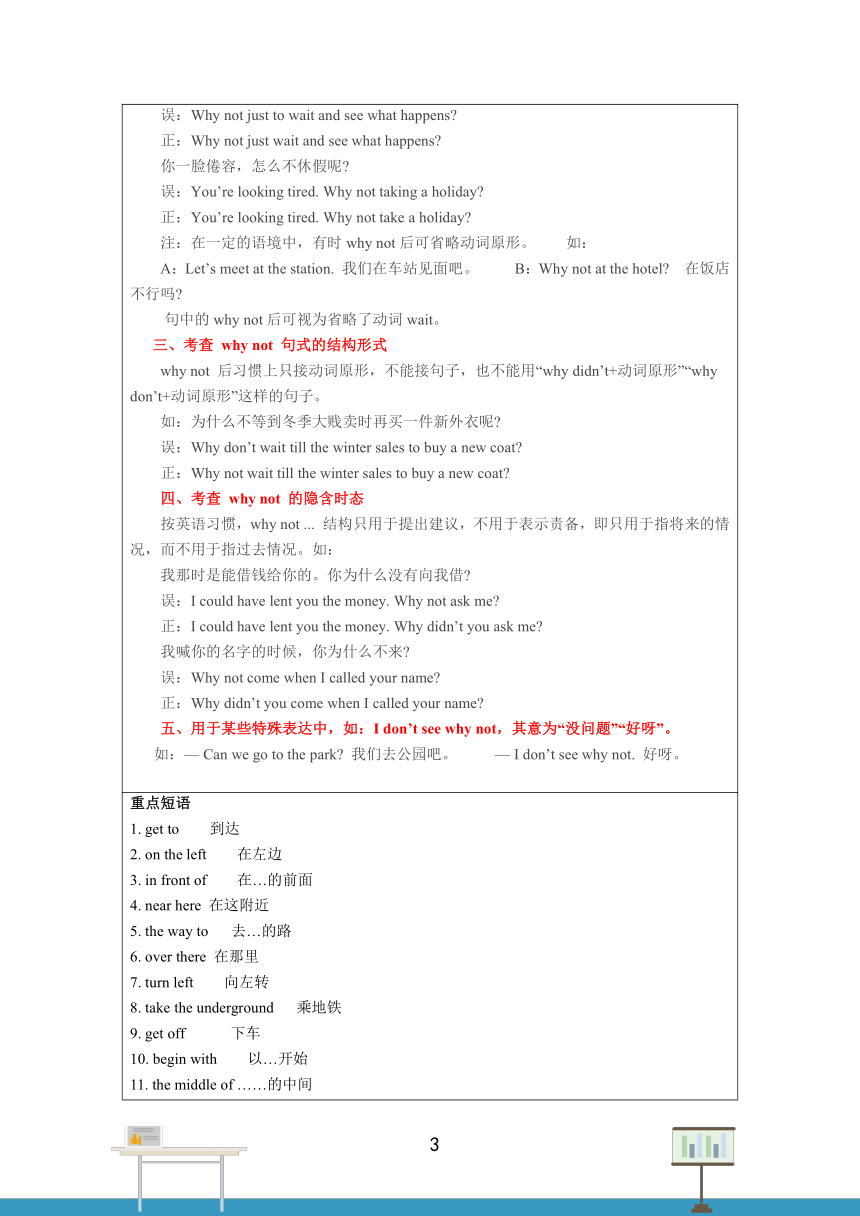
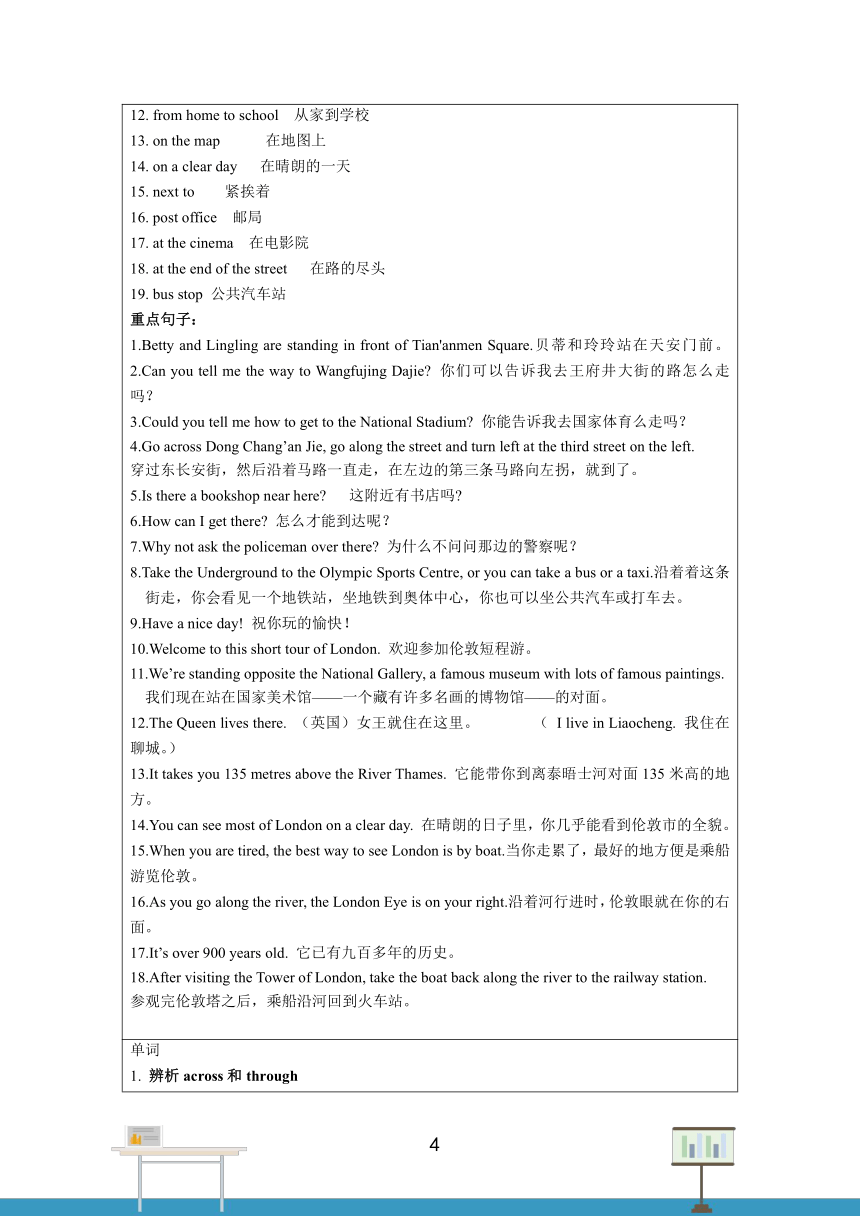
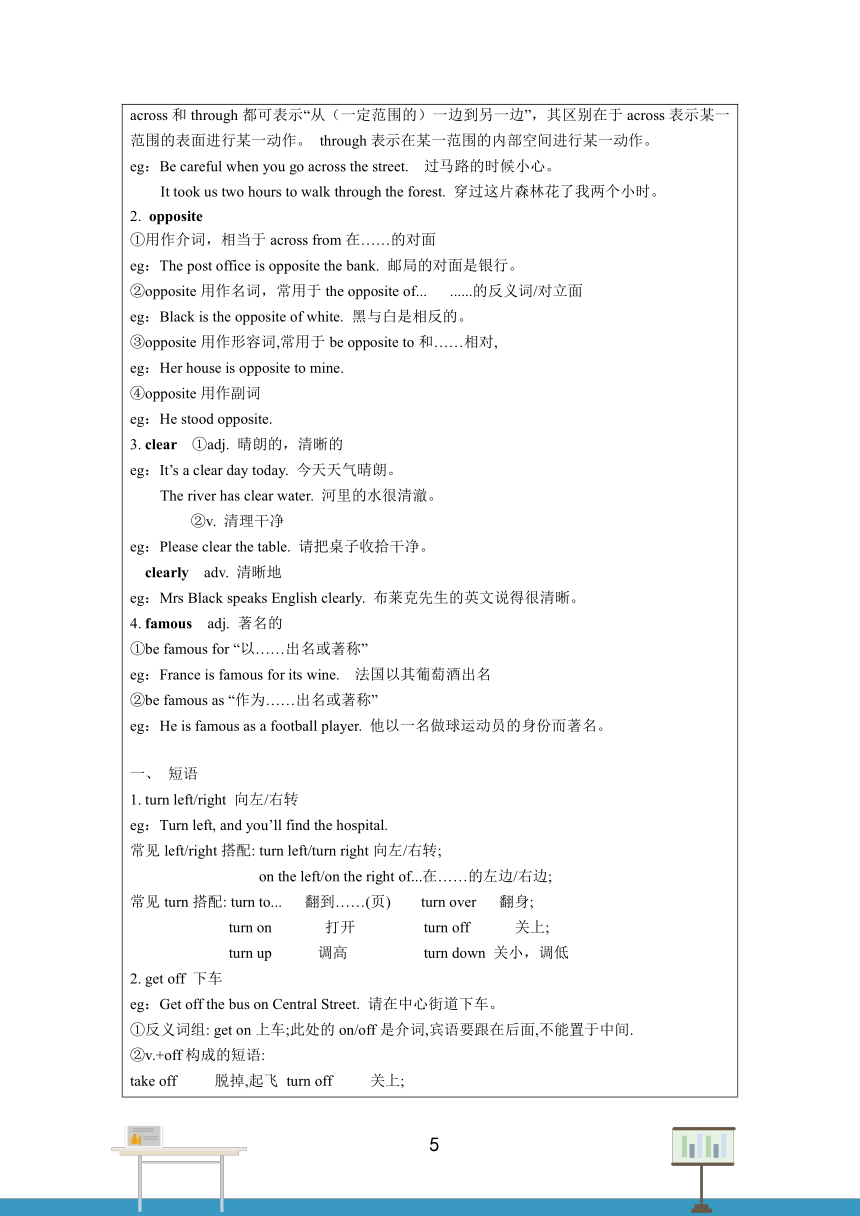
文档简介
Module 6 Around town知识归纳与练习
Nounbank[b k]n.银行 ---banksmuseum[mju'zi: m]n. 博物馆---museums tourist ['t rist]n. 游客 ---touristsstreet[stri:t]n. 街道 ---streetsguidebook ['gaidb k]n. 导游手册; 旅行指南 ---guidebooks bookshop ['b k p]n. 书店 ---bookshopsunderground [ nd 'ɡra nd]n. 地铁 ---undergroundstour[tu ]n. (短期的)参观,游览; 旅行 ---tourssquare[skwe (r)]n. 广场 ---squaresmiddle ['midl]n. 中部; 中间 adj.中等的; 中部的---middles painting['peinti ]n.油画; 绘画 ---paintingsmetre['mi:t (r)](Am E meter) n. 米 ---metresriver['riv (r)]n. 河; 江 ---riversbridge [brid ]n. 桥 ---bridgesrailway ['reilwei]n. 铁路 ---railwayschurch[t :t ]n. 教堂 ---churchesstop[st p]n. 车站 ---stopsVerbcross [kr s]v. 穿过 ---crossed/crossedexcuse [ik'skju:s]v. 原谅; 谅解 ---excused/excusedturn [t :n]v. 换方向 ---turned/turnedcould[k d]v. aux. 可以; 能 take[teik]v. 搭乘; 乘坐; 固定使用; 把(某人)带往; 使(某人)到---took/takenfinish ['fini ]v. 结束; 完成 ---finished/finishedPrepositionalong [ 'l ]prep. 沿着 across[ 'kr s]prep.越过 opposite [' p zit]prep. 在……的对面 from[fr m]prep. 从……出发 above[ 'b v]prep. 在……上方; 在……之上 past[pɑ:st]prep. 路过(某物或某地);越过 up [ p]prep. 沿着......而去. down[da n]prep. 沿着 Adjectivefamous['feim s]adj. 著名的clear[kli (r)]adj. (天气)晴朗的high [hai]adj. 高的Phrasepost office [p ust ' fis]邮政局excuse me 对不起,劳驾,打扰一下(用于礼貌地引起注意,尤其是要提问时)Ordinal numberthird[θ :d]num. 第三Interjection感叹词right int. 好了(用于变换话题或活动); 是的; 好Special interrogative words特殊疑问词Why not... 为什么不……呢 一、考查 why not 在口语中主要有以下用法。 1. 表示劝诱、建议或命令,意为:……怎么样;为什么不……呢。如: A:My girl-friend is in a bad mood. 我的女朋友情绪不好。 B:Why not give her some flowers 为什么不送她一些花呢 2. 表示同意或赞成,意为:好的;可以呀;为什么不可以呢。如: A:May I go with you 我可以和你一起去吗 B:Why not 可以呀。 A:Let’s eat out tonight. 今晚我们出去吃吧。 B:Yes, why not 那好啊。 A:I wonder if I could make a living by writing. 我不知靠写作能否维持生计。 B:Why not 那可以呀。 3. 用来询问原因(有时表示一种不可理解的心情),意为:为什么;为什么不……呢。如: A:He isn’t going to see her off at the station. 他不准备去车站送她。 B:Why not 为什么 A:You should not smoke. 你不该抽烟。 B:Why not 为什么 A:Don’t touch it. 别碰它。 B:Why not 为什么 4. 表示坚持自己的观点、态度或做法,意为:为什么不呢。如: A:Are you really going to sue them 你真的要控告他们吗 B:Yes, why not 是的,为什么不呢 二、考查 why not 后的动词用何形式 why not 后习惯上只接动词原形,不能接带 to 不定式或现在分词。如: 何不静观其结果呢 误:Why not just to wait and see what happens 正:Why not just wait and see what happens 你一脸倦容,怎么不休假呢 误:You’re looking tired. Why not taking a holiday 正:You’re looking tired. Why not take a holiday 注:在一定的语境中,有时why not后可省略动词原形。 如: A:Let’s meet at the station. 我们在车站见面吧。 B:Why not at the hotel 在饭店不行吗 句中的why not后可视为省略了动词wait。三、考查 why not 句式的结构形式 why not 后习惯上只接动词原形,不能接句子,也不能用“why didn’t+动词原形”“why don’t+动词原形”这样的句子。 如:为什么不等到冬季大贱卖时再买一件新外衣呢 误:Why don’t wait till the winter sales to buy a new coat 正:Why not wait till the winter sales to buy a new coat 四、考查 why not 的隐含时态 按英语习惯,why not ... 结构只用于提出建议,不用于表示责备,即只用于指将来的情况,而不用于指过去情况。如: 我那时是能借钱给你的。你为什么没有向我借 误:I could have lent you the money. Why not ask me 正:I could have lent you the money. Why didn’t you ask me 我喊你的名字的时候,你为什么不来 误:Why not come when I called your name 正:Why didn’t you come when I called your name 五、用于某些特殊表达中,如:I don’t see why not,其意为“没问题”“好呀”。如:— Can we go to the park 我们去公园吧。 — I don’t see why not. 好呀。
重点短语1. get to 到达2. on the left 在左边3. in front of 在…的前面4. near here 在这附近5. the way to 去…的路6. over there 在那里7. turn left 向左转8. take the underground 乘地铁9. get off 下车10. begin with 以…开始11. the middle of ……的中间12. from home to school 从家到学校13. on the map 在地图上 14. on a clear day 在晴朗的一天15. next to 紧挨着16. post office 邮局17. at the cinema 在电影院18. at the end of the street 在路的尽头19. bus stop 公共汽车站重点句子:1.Betty and Lingling are standing in front of Tian'anmen Square.贝蒂和玲玲站在天安门前。 ( http: / / www.xkb1.com / )2.Can you tell me the way to Wangfujing Dajie 你们可以告诉我去王府井大街的路怎么走吗?3.Could you tell me how to get to the National Stadium 你能告诉我去国家体育么走吗?4.Go across Dong Chang’an Jie, go along the street and turn left at the third street on the left. 穿过东长安街,然后沿着马路一直走,在左边的第三条马路向左拐,就到了。5.Is there a bookshop near here 这附近有书店吗 6.How can I get there 怎么才能到达呢?7.Why not ask the policeman over there 为什么不问问那边的警察呢?8.Take the Underground to the Olympic Sports Centre, or you can take a bus or a taxi.沿着着这条街走,你会看见一个地铁站,坐地铁到奥体中心,你也可以坐公共汽车或打车去。9.Have a nice day! 祝你玩的愉快!10.Welcome to this short tour of London. 欢迎参加伦敦短程游。11.We’re standing opposite the National Gallery, a famous museum with lots of famous paintings.我们现在站在国家美术馆——一个藏有许多名画的博物馆——的对面。12.The Queen lives there. (英国)女王就住在这里。 ( I live in Liaocheng. 我住在聊城。)13.It takes you 135 metres above the River Thames. 它能带你到离泰晤士河对面135米高的地方。14.You can see most of London on a clear day. 在晴朗的日子里,你几乎能看到伦敦市的全貌。 15.When you are tired, the best way to see London is by boat.当你走累了,最好的地方便是乘船游览伦敦。16.As you go along the river, the London Eye is on your right.沿着河行进时,伦敦眼就在你的右面。17.It’s over 900 years old. 它已有九百多年的历史。18.After visiting the Tower of London, take the boat back along the river to the railway station.参观完伦敦塔之后,乘船沿河回到火车站。
单词1. 辨析across和throughacross和through都可表示“从(一定范围的)一边到另一边”,其区别在于across表示某一范围的表面进行某一动作。 through表示在某一范围的内部空间进行某一动作。eg:Be careful when you go across the street. 过马路的时候小心。It took us two hours to walk through the forest. 穿过这片森林花了我两个小时。opposite①用作介词,相当于across from在……的对面eg:The post office is opposite the bank. 邮局的对面是银行。②opposite用作名词,常用于the opposite of... ......的反义词/对立面 eg:Black is the opposite of white. 黑与白是相反的。③opposite用作形容词,常用于be opposite to和……相对,eg:Her house is opposite to mine. ④opposite用作副词 eg:He stood opposite.3. clear ①adj. 晴朗的,清晰的 eg:It’s a clear day today. 今天天气晴朗。 The river has clear water. 河里的水很清澈。 ②v. 清理干净eg:Please clear the table. 请把桌子收拾干净。 clearly adv. 清晰地eg:Mrs Black speaks English clearly. 布莱克先生的英文说得很清晰。4. famous adj. 著名的①be famous for “以……出名或著称” eg:France is famous for its wine. 法国以其葡萄酒出名②be famous as “作为……出名或著称” eg:He is famous as a football player. 他以一名做球运动员的身份而著名。 短语1. turn left/right 向左/右转 eg:Turn left, and you’ll find the hospital. 常见left/right搭配: turn left/turn right向左/右转; on the left/on the right of...在……的左边/右边; 常见turn搭配: turn to... 翻到……(页) turn over 翻身; turn on 打开 turn off 关上; turn up 调高 turn down 关小,调低2. get off 下车 eg:Get off the bus on Central Street. 请在中心街道下车。①反义词组: get on上车;此处的on/off是介词,宾语要跟在后面,不能置于中间. ②v.+off构成的短语: take off 脱掉,起飞 turn off 关上; keep off 不让……进入; fall off 从……摔下来have...off 休息……; set off 出发,动身3. next to 在……的旁边,紧靠 eg:The post office is next to our school. ①next to是介词短语,后接名词或代词②同义词:beside prep.在……旁边知识拓展交通方式的表达方法: ①用介词表示 by +交通工具单数 eg: by car/bus/taxi… in/on +a/an/the/one’s/this/that 等限定词+交通工具 eg: in the car/taxi… on the bus/ship/plane… by + 表示交通线路或交通线路所经范围的名词 eg:by land 由陆路 by sea/ by water由水路 by road由公路 by rail由铁路 by air 乘飞机 ②用动词表示 “动词 + to + 地点名词”或“动词 + 地点副词” eg:walk /ride/drive/fly/sail to sp. “take a/the +交通工具单数”,表示“乘/坐 eg:I often go to school by bus. (同义句) I often go to school on a bus. I often take the bus to school.2. 方位介词 用法总结(1) over, above和on的用法①over指在…的正上方,表示垂直在上。eg:There is a lamp over the desk. 桌子上方有一个灯泡。②above指在上方,属于斜上方。eg:Raise your arms above your head. 把手臂举到头上。③on指在上面,表示两物体接触。eg:There is a cup on the table. 桌子上有一个杯子。(2) under / below的用法:①under在……下面/正下方.eg:What's under your desk 桌子下面是什么? ②below 在……斜下方eg:Her skirt came below her knees. 她的裙子跑到了膝盖上面。(3) in和on表示“在……上”①门一类——镶嵌在墙里的,用in,字画一类——挂在墙面上的,用on.②鸟一类落在树上的,用in;苹果一类长在树上的,用on.in /on/ to表示方位in表示在某范围之内; to表示在某范围之外; on表示“邻”、“接壤”。eg:Shanghai lies in the east of China. 上海位于中国东部。 Japan lies to the east of China. 日本在中国东部。 Mongolia(蒙古国)lies on the north of China. 蒙古人民共和国位于中国北部。(5) at, in表示“在……”①at表示较小的地点。eg:at the bus stop/at home2)in表示较大的地点。eg:in China/in the world(6) in front of 和in the front of ①in front of表示“在…之前”(范围外)。eg:There are some trees in front of the classroom. 教室前面有几棵树。②in the front of 表示“在…的前部”(范围内)eg:There is a blackboard in the front of the classroom. 黑板在教室的前面。(7) through / across通过,穿过①across表示横过,即从物体表面通过,与on有关,为二维 ②through穿过,即从物体内部穿过,与in有关,为三维。
Module6 Around town 课后练习
题一:
请翻译:你能告诉我如何去学校吗?
题二:
请翻译:你能告诉我如何去图书馆吗?
题三:
1. 请翻译:沿着这条街走,在第一个十字路口向左拐,你就能找到那家医院。
2. _______the music.It’s too loud.
A. Turn on B. Turn down C. Turn up
题四:
1.请翻译:沿着这条路走,你会走到一个公共汽车站。
2. _______ the radio, or you will wake up your father.
A. Turn on B. Turn down C. Turn up
题五:
请翻译:为什么不留下喝杯茶呢?
题六:
请翻译:为什么不帮助你母亲做家务
题七:
1.请翻译:去上海最安全的方式是坐火车。
2. He would like to go there by _____ boat.
A. the B. a C./ D. an
题八:
1. 如今许多人乘飞机旅行。
2. He wants to go to his hometown by _____ air.
A. the B. a C./ D. an
题九:
请翻译:
1. 乘这辆公共汽车,到火车站下车。
2. 这位司机经常帮助那位老人上他的出租车。
题十:
请翻译:
1. 你将在哪里下车?
2 这个小男孩很想上这辆小汽车。
题十一:
翻译题:
1.他在桌子旁边。
2.教室里有60名学生。
3.那顶帽子在床上。
4.我的球在课桌下面。
5.那个小男孩在树后。
6.在房子后面有一辆小汽车。
7.他在我的右边。
8.他紧挨着他的妹妹。
9.那家银行就在街道的拐角处。
10.我通常在周二和周五中间是不忙的。
选择题:
His house is ______ the trees.
A. between B. among C. in
题十二:
1. 我的那只猫在门口。
2. 我的那支钢笔在铅笔盒里。
3. 他的书包在椅子上。
4. 我的钢笔在那本书下面。
5. 那个小女孩在椅子后面。
6. 在我的书包里有一些书。
7. 那张课桌在我的左边。
8. 那家医院紧挨着我的学校。
9. 他家的房子就在街道的拐角处。
10. 在桌子与椅子中间有一个足球。
选择题:
My village is ____hills.
A. between B. among C. in
题十三:
假如我是Tom,你将在你家开一个生日party,但是你的朋友Henry不知道去你家的路。请你写一封信介绍去你的路线。
提示:
1. 你家位于Bridge Street
2. 坐5路公共汽车到center street
3. 沿着center street一直向前走,当看到一个大的超市时向右转,就能进入bridge street。沿着bridge street一直走,你的家在小公园和图书馆的中间,是一座带花园的白色房子。
题十四:
假如你叫王华,你的朋友John想去你家玩,可是他不知道怎么走,你家在重庆路12号,乘坐2路或3号车在幸福路下车,家就在车站旁边。房子是红色的, 门是白色的,很容易找到的。你来到我家后我们可以唱歌和跳舞,也可以吃一些蛋糕,水果和小吃。
课后练习参考答案
题一:Can you tell me the way to school
解析:问路的常见用语是“Can you tell sb. the way to+地点”。
题二:Could you tell me how to get to the library?
解析:问路的其它方式还包括“Could you tell me how to get to+地点”。
题三:
1. Go down this street,then turn to the left at the first crossing and you will find the hospital.
2. B
解析:
1. turn to the left向左拐;at the first crossing在第一个十字路口。
2.句意:请关小一点音乐,太吵了。turn on打开;turn down 关小一点;turn up开大一点。 根据句意故选B。
题四:
1. Go down the road and you’ll come to a bus stop.
2. B
解析:
1. Go down the road沿着这条路走。
2. 把收音机的声音调小些,不然会把你的父亲吵醒。turn on打开;turn down关小一点;turn up开大一点。 根据句意故选B。
题五:Why not stay for a cup of tea
解析:Why not+动词原形“表示一种建议”。
题六:Why not help your mother with the housework
解析:Why not+动词原形“表示一种建议”。
题七:
1. The safest way to Shanghai is by train.
2. C
解析:
1. by +表示交通工具的名词,名词前不能加冠词。by train坐火车。
2. by +表示交通工具的名词,名词前不能加冠词。句意:他想坐船去那里。
题八:
1. Nowadays many people travel by plane.
2. C
解析:
1. by +表示交通工具的名词,名词前不能加冠词。
2. 句意:他想做飞机回家乡。by air坐飞机。
题九:
1. Get on this bus and get off at the station.
2. He often helps the old man get in his taxi.
解析:
1. get off 下车。at the station在火车站。
2. get in上车,一般指上的是空间小的,底盘比较低,不用费力抬腿的车子。如taxi或car等。
题十:
1. Where will you get off
2. The boy would like to get in the car.
解析:
1. get off下车。
2.would like to do想要做某事;get in上车,一般指上的是空间小的,底盘比较低,不用费力抬腿的车子。如taxi或car等。
题十一:
1. He is at the table.
2. There are sixty students in the classroom.
3. That cap is on the bed.
4. My ball is under the desk.
5. That boy is behind the tree.
6. There is a car behind the house.
7. He is on my right.
8. He is next to his sister.
9. That bank is on the corner of the street.
10. I’m usually free between Tuesday and Friday.
选择题:B
解析:
1. at the table在桌子旁。
2. in the classroom在教室里。
3. on the bed在床上。
4. under the desk.在桌子下。
5. behind the tree在树后。
6. behind the house在房后。
7. on my right在右边。
8. next to紧挨着。
9. on the corner of the street.在街道的拐角处。
10.be free 闲的,不忙的。between…and…表示在两者之间。
选择题:
句意:他的房子隐藏在树林之中。among指在三个或三个以上的人或事物之间。
题十二:
1. My cat is at the door.
2. My pen is in the pencil box.
3. His schoolbag is on the chair.
4. My pen is under the book.
5. That girl is behind the chair.
6. There are some books in my schoolbag.
7. That desk is on my left.
8. The hospital is next to my school.
9. His house is on the corner of the street.
10. There is a football between the table and the chair.
选择题:B
解析:
1. at the door在门口。
2. in the pencil box在铅笔盒里。
3. on the chair在椅子上。
4. under the book在书的下面。
5. behind the chair在椅子后面。
6. in my schoolbag 在我的书包里。
7. on my left.在我的左边。
8. next to紧挨着。
9. on the corner of the street在街道的拐角处。
10. between…and…表示在两者之间。
选择题:
句意:我的村子群山环绕。among指在三个或三个以上的人或事物之间。
题十三:
Dear Henry,
I am writing to tell how to get to my house. My home is on Bridge Street. You can take No.5 to center street. Go along center street, you will see a big supermarket. Then you turn right. You walk along bridge street .My home is between the park and the library. It is a white house with a garden.
Yours,
Tom
题十四:
Dear John,
I live at No. 12, Chongqing Road. You can take No.2 bus or No.3 bus and get off at Xingfu Road bus stop. My home is next to the bus stop. My house is red and the door is white, so it is easy to find my house. We can sing and dance on that day. We can also have cakes , fruit and many snacks. I think we will have a good time. I hope you will come at 7p.m.
Yours,
Wang Hua
Nounbank[b k]n.银行 ---banksmuseum[mju'zi: m]n. 博物馆---museums tourist ['t rist]n. 游客 ---touristsstreet[stri:t]n. 街道 ---streetsguidebook ['gaidb k]n. 导游手册; 旅行指南 ---guidebooks bookshop ['b k p]n. 书店 ---bookshopsunderground [ nd 'ɡra nd]n. 地铁 ---undergroundstour[tu ]n. (短期的)参观,游览; 旅行 ---tourssquare[skwe (r)]n. 广场 ---squaresmiddle ['midl]n. 中部; 中间 adj.中等的; 中部的---middles painting['peinti ]n.油画; 绘画 ---paintingsmetre['mi:t (r)](Am E meter) n. 米 ---metresriver['riv (r)]n. 河; 江 ---riversbridge [brid ]n. 桥 ---bridgesrailway ['reilwei]n. 铁路 ---railwayschurch[t :t ]n. 教堂 ---churchesstop[st p]n. 车站 ---stopsVerbcross [kr s]v. 穿过 ---crossed/crossedexcuse [ik'skju:s]v. 原谅; 谅解 ---excused/excusedturn [t :n]v. 换方向 ---turned/turnedcould[k d]v. aux. 可以; 能 take[teik]v. 搭乘; 乘坐; 固定使用; 把(某人)带往; 使(某人)到---took/takenfinish ['fini ]v. 结束; 完成 ---finished/finishedPrepositionalong [ 'l ]prep. 沿着 across[ 'kr s]prep.越过 opposite [' p zit]prep. 在……的对面 from[fr m]prep. 从……出发 above[ 'b v]prep. 在……上方; 在……之上 past[pɑ:st]prep. 路过(某物或某地);越过 up [ p]prep. 沿着......而去. down[da n]prep. 沿着 Adjectivefamous['feim s]adj. 著名的clear[kli (r)]adj. (天气)晴朗的high [hai]adj. 高的Phrasepost office [p ust ' fis]邮政局excuse me 对不起,劳驾,打扰一下(用于礼貌地引起注意,尤其是要提问时)Ordinal numberthird[θ :d]num. 第三Interjection感叹词right int. 好了(用于变换话题或活动); 是的; 好Special interrogative words特殊疑问词Why not... 为什么不……呢 一、考查 why not 在口语中主要有以下用法。 1. 表示劝诱、建议或命令,意为:……怎么样;为什么不……呢。如: A:My girl-friend is in a bad mood. 我的女朋友情绪不好。 B:Why not give her some flowers 为什么不送她一些花呢 2. 表示同意或赞成,意为:好的;可以呀;为什么不可以呢。如: A:May I go with you 我可以和你一起去吗 B:Why not 可以呀。 A:Let’s eat out tonight. 今晚我们出去吃吧。 B:Yes, why not 那好啊。 A:I wonder if I could make a living by writing. 我不知靠写作能否维持生计。 B:Why not 那可以呀。 3. 用来询问原因(有时表示一种不可理解的心情),意为:为什么;为什么不……呢。如: A:He isn’t going to see her off at the station. 他不准备去车站送她。 B:Why not 为什么 A:You should not smoke. 你不该抽烟。 B:Why not 为什么 A:Don’t touch it. 别碰它。 B:Why not 为什么 4. 表示坚持自己的观点、态度或做法,意为:为什么不呢。如: A:Are you really going to sue them 你真的要控告他们吗 B:Yes, why not 是的,为什么不呢 二、考查 why not 后的动词用何形式 why not 后习惯上只接动词原形,不能接带 to 不定式或现在分词。如: 何不静观其结果呢 误:Why not just to wait and see what happens 正:Why not just wait and see what happens 你一脸倦容,怎么不休假呢 误:You’re looking tired. Why not taking a holiday 正:You’re looking tired. Why not take a holiday 注:在一定的语境中,有时why not后可省略动词原形。 如: A:Let’s meet at the station. 我们在车站见面吧。 B:Why not at the hotel 在饭店不行吗 句中的why not后可视为省略了动词wait。三、考查 why not 句式的结构形式 why not 后习惯上只接动词原形,不能接句子,也不能用“why didn’t+动词原形”“why don’t+动词原形”这样的句子。 如:为什么不等到冬季大贱卖时再买一件新外衣呢 误:Why don’t wait till the winter sales to buy a new coat 正:Why not wait till the winter sales to buy a new coat 四、考查 why not 的隐含时态 按英语习惯,why not ... 结构只用于提出建议,不用于表示责备,即只用于指将来的情况,而不用于指过去情况。如: 我那时是能借钱给你的。你为什么没有向我借 误:I could have lent you the money. Why not ask me 正:I could have lent you the money. Why didn’t you ask me 我喊你的名字的时候,你为什么不来 误:Why not come when I called your name 正:Why didn’t you come when I called your name 五、用于某些特殊表达中,如:I don’t see why not,其意为“没问题”“好呀”。如:— Can we go to the park 我们去公园吧。 — I don’t see why not. 好呀。
重点短语1. get to 到达2. on the left 在左边3. in front of 在…的前面4. near here 在这附近5. the way to 去…的路6. over there 在那里7. turn left 向左转8. take the underground 乘地铁9. get off 下车10. begin with 以…开始11. the middle of ……的中间12. from home to school 从家到学校13. on the map 在地图上 14. on a clear day 在晴朗的一天15. next to 紧挨着16. post office 邮局17. at the cinema 在电影院18. at the end of the street 在路的尽头19. bus stop 公共汽车站重点句子:1.Betty and Lingling are standing in front of Tian'anmen Square.贝蒂和玲玲站在天安门前。 ( http: / / www.xkb1.com / )2.Can you tell me the way to Wangfujing Dajie 你们可以告诉我去王府井大街的路怎么走吗?3.Could you tell me how to get to the National Stadium 你能告诉我去国家体育么走吗?4.Go across Dong Chang’an Jie, go along the street and turn left at the third street on the left. 穿过东长安街,然后沿着马路一直走,在左边的第三条马路向左拐,就到了。5.Is there a bookshop near here 这附近有书店吗 6.How can I get there 怎么才能到达呢?7.Why not ask the policeman over there 为什么不问问那边的警察呢?8.Take the Underground to the Olympic Sports Centre, or you can take a bus or a taxi.沿着着这条街走,你会看见一个地铁站,坐地铁到奥体中心,你也可以坐公共汽车或打车去。9.Have a nice day! 祝你玩的愉快!10.Welcome to this short tour of London. 欢迎参加伦敦短程游。11.We’re standing opposite the National Gallery, a famous museum with lots of famous paintings.我们现在站在国家美术馆——一个藏有许多名画的博物馆——的对面。12.The Queen lives there. (英国)女王就住在这里。 ( I live in Liaocheng. 我住在聊城。)13.It takes you 135 metres above the River Thames. 它能带你到离泰晤士河对面135米高的地方。14.You can see most of London on a clear day. 在晴朗的日子里,你几乎能看到伦敦市的全貌。 15.When you are tired, the best way to see London is by boat.当你走累了,最好的地方便是乘船游览伦敦。16.As you go along the river, the London Eye is on your right.沿着河行进时,伦敦眼就在你的右面。17.It’s over 900 years old. 它已有九百多年的历史。18.After visiting the Tower of London, take the boat back along the river to the railway station.参观完伦敦塔之后,乘船沿河回到火车站。
单词1. 辨析across和throughacross和through都可表示“从(一定范围的)一边到另一边”,其区别在于across表示某一范围的表面进行某一动作。 through表示在某一范围的内部空间进行某一动作。eg:Be careful when you go across the street. 过马路的时候小心。It took us two hours to walk through the forest. 穿过这片森林花了我两个小时。opposite①用作介词,相当于across from在……的对面eg:The post office is opposite the bank. 邮局的对面是银行。②opposite用作名词,常用于the opposite of... ......的反义词/对立面 eg:Black is the opposite of white. 黑与白是相反的。③opposite用作形容词,常用于be opposite to和……相对,eg:Her house is opposite to mine. ④opposite用作副词 eg:He stood opposite.3. clear ①adj. 晴朗的,清晰的 eg:It’s a clear day today. 今天天气晴朗。 The river has clear water. 河里的水很清澈。 ②v. 清理干净eg:Please clear the table. 请把桌子收拾干净。 clearly adv. 清晰地eg:Mrs Black speaks English clearly. 布莱克先生的英文说得很清晰。4. famous adj. 著名的①be famous for “以……出名或著称” eg:France is famous for its wine. 法国以其葡萄酒出名②be famous as “作为……出名或著称” eg:He is famous as a football player. 他以一名做球运动员的身份而著名。 短语1. turn left/right 向左/右转 eg:Turn left, and you’ll find the hospital. 常见left/right搭配: turn left/turn right向左/右转; on the left/on the right of...在……的左边/右边; 常见turn搭配: turn to... 翻到……(页) turn over 翻身; turn on 打开 turn off 关上; turn up 调高 turn down 关小,调低2. get off 下车 eg:Get off the bus on Central Street. 请在中心街道下车。①反义词组: get on上车;此处的on/off是介词,宾语要跟在后面,不能置于中间. ②v.+off构成的短语: take off 脱掉,起飞 turn off 关上; keep off 不让……进入; fall off 从……摔下来have...off 休息……; set off 出发,动身3. next to 在……的旁边,紧靠 eg:The post office is next to our school. ①next to是介词短语,后接名词或代词②同义词:beside prep.在……旁边知识拓展交通方式的表达方法: ①用介词表示 by +交通工具单数 eg: by car/bus/taxi… in/on +a/an/the/one’s/this/that 等限定词+交通工具 eg: in the car/taxi… on the bus/ship/plane… by + 表示交通线路或交通线路所经范围的名词 eg:by land 由陆路 by sea/ by water由水路 by road由公路 by rail由铁路 by air 乘飞机 ②用动词表示 “动词 + to + 地点名词”或“动词 + 地点副词” eg:walk /ride/drive/fly/sail to sp. “take a/the +交通工具单数”,表示“乘/坐 eg:I often go to school by bus. (同义句) I often go to school on a bus. I often take the bus to school.2. 方位介词 用法总结(1) over, above和on的用法①over指在…的正上方,表示垂直在上。eg:There is a lamp over the desk. 桌子上方有一个灯泡。②above指在上方,属于斜上方。eg:Raise your arms above your head. 把手臂举到头上。③on指在上面,表示两物体接触。eg:There is a cup on the table. 桌子上有一个杯子。(2) under / below的用法:①under在……下面/正下方.eg:What's under your desk 桌子下面是什么? ②below 在……斜下方eg:Her skirt came below her knees. 她的裙子跑到了膝盖上面。(3) in和on表示“在……上”①门一类——镶嵌在墙里的,用in,字画一类——挂在墙面上的,用on.②鸟一类落在树上的,用in;苹果一类长在树上的,用on.in /on/ to表示方位in表示在某范围之内; to表示在某范围之外; on表示“邻”、“接壤”。eg:Shanghai lies in the east of China. 上海位于中国东部。 Japan lies to the east of China. 日本在中国东部。 Mongolia(蒙古国)lies on the north of China. 蒙古人民共和国位于中国北部。(5) at, in表示“在……”①at表示较小的地点。eg:at the bus stop/at home2)in表示较大的地点。eg:in China/in the world(6) in front of 和in the front of ①in front of表示“在…之前”(范围外)。eg:There are some trees in front of the classroom. 教室前面有几棵树。②in the front of 表示“在…的前部”(范围内)eg:There is a blackboard in the front of the classroom. 黑板在教室的前面。(7) through / across通过,穿过①across表示横过,即从物体表面通过,与on有关,为二维 ②through穿过,即从物体内部穿过,与in有关,为三维。
Module6 Around town 课后练习
题一:
请翻译:你能告诉我如何去学校吗?
题二:
请翻译:你能告诉我如何去图书馆吗?
题三:
1. 请翻译:沿着这条街走,在第一个十字路口向左拐,你就能找到那家医院。
2. _______the music.It’s too loud.
A. Turn on B. Turn down C. Turn up
题四:
1.请翻译:沿着这条路走,你会走到一个公共汽车站。
2. _______ the radio, or you will wake up your father.
A. Turn on B. Turn down C. Turn up
题五:
请翻译:为什么不留下喝杯茶呢?
题六:
请翻译:为什么不帮助你母亲做家务
题七:
1.请翻译:去上海最安全的方式是坐火车。
2. He would like to go there by _____ boat.
A. the B. a C./ D. an
题八:
1. 如今许多人乘飞机旅行。
2. He wants to go to his hometown by _____ air.
A. the B. a C./ D. an
题九:
请翻译:
1. 乘这辆公共汽车,到火车站下车。
2. 这位司机经常帮助那位老人上他的出租车。
题十:
请翻译:
1. 你将在哪里下车?
2 这个小男孩很想上这辆小汽车。
题十一:
翻译题:
1.他在桌子旁边。
2.教室里有60名学生。
3.那顶帽子在床上。
4.我的球在课桌下面。
5.那个小男孩在树后。
6.在房子后面有一辆小汽车。
7.他在我的右边。
8.他紧挨着他的妹妹。
9.那家银行就在街道的拐角处。
10.我通常在周二和周五中间是不忙的。
选择题:
His house is ______ the trees.
A. between B. among C. in
题十二:
1. 我的那只猫在门口。
2. 我的那支钢笔在铅笔盒里。
3. 他的书包在椅子上。
4. 我的钢笔在那本书下面。
5. 那个小女孩在椅子后面。
6. 在我的书包里有一些书。
7. 那张课桌在我的左边。
8. 那家医院紧挨着我的学校。
9. 他家的房子就在街道的拐角处。
10. 在桌子与椅子中间有一个足球。
选择题:
My village is ____hills.
A. between B. among C. in
题十三:
假如我是Tom,你将在你家开一个生日party,但是你的朋友Henry不知道去你家的路。请你写一封信介绍去你的路线。
提示:
1. 你家位于Bridge Street
2. 坐5路公共汽车到center street
3. 沿着center street一直向前走,当看到一个大的超市时向右转,就能进入bridge street。沿着bridge street一直走,你的家在小公园和图书馆的中间,是一座带花园的白色房子。
题十四:
假如你叫王华,你的朋友John想去你家玩,可是他不知道怎么走,你家在重庆路12号,乘坐2路或3号车在幸福路下车,家就在车站旁边。房子是红色的, 门是白色的,很容易找到的。你来到我家后我们可以唱歌和跳舞,也可以吃一些蛋糕,水果和小吃。
课后练习参考答案
题一:Can you tell me the way to school
解析:问路的常见用语是“Can you tell sb. the way to+地点”。
题二:Could you tell me how to get to the library?
解析:问路的其它方式还包括“Could you tell me how to get to+地点”。
题三:
1. Go down this street,then turn to the left at the first crossing and you will find the hospital.
2. B
解析:
1. turn to the left向左拐;at the first crossing在第一个十字路口。
2.句意:请关小一点音乐,太吵了。turn on打开;turn down 关小一点;turn up开大一点。 根据句意故选B。
题四:
1. Go down the road and you’ll come to a bus stop.
2. B
解析:
1. Go down the road沿着这条路走。
2. 把收音机的声音调小些,不然会把你的父亲吵醒。turn on打开;turn down关小一点;turn up开大一点。 根据句意故选B。
题五:Why not stay for a cup of tea
解析:Why not+动词原形“表示一种建议”。
题六:Why not help your mother with the housework
解析:Why not+动词原形“表示一种建议”。
题七:
1. The safest way to Shanghai is by train.
2. C
解析:
1. by +表示交通工具的名词,名词前不能加冠词。by train坐火车。
2. by +表示交通工具的名词,名词前不能加冠词。句意:他想坐船去那里。
题八:
1. Nowadays many people travel by plane.
2. C
解析:
1. by +表示交通工具的名词,名词前不能加冠词。
2. 句意:他想做飞机回家乡。by air坐飞机。
题九:
1. Get on this bus and get off at the station.
2. He often helps the old man get in his taxi.
解析:
1. get off 下车。at the station在火车站。
2. get in上车,一般指上的是空间小的,底盘比较低,不用费力抬腿的车子。如taxi或car等。
题十:
1. Where will you get off
2. The boy would like to get in the car.
解析:
1. get off下车。
2.would like to do想要做某事;get in上车,一般指上的是空间小的,底盘比较低,不用费力抬腿的车子。如taxi或car等。
题十一:
1. He is at the table.
2. There are sixty students in the classroom.
3. That cap is on the bed.
4. My ball is under the desk.
5. That boy is behind the tree.
6. There is a car behind the house.
7. He is on my right.
8. He is next to his sister.
9. That bank is on the corner of the street.
10. I’m usually free between Tuesday and Friday.
选择题:B
解析:
1. at the table在桌子旁。
2. in the classroom在教室里。
3. on the bed在床上。
4. under the desk.在桌子下。
5. behind the tree在树后。
6. behind the house在房后。
7. on my right在右边。
8. next to紧挨着。
9. on the corner of the street.在街道的拐角处。
10.be free 闲的,不忙的。between…and…表示在两者之间。
选择题:
句意:他的房子隐藏在树林之中。among指在三个或三个以上的人或事物之间。
题十二:
1. My cat is at the door.
2. My pen is in the pencil box.
3. His schoolbag is on the chair.
4. My pen is under the book.
5. That girl is behind the chair.
6. There are some books in my schoolbag.
7. That desk is on my left.
8. The hospital is next to my school.
9. His house is on the corner of the street.
10. There is a football between the table and the chair.
选择题:B
解析:
1. at the door在门口。
2. in the pencil box在铅笔盒里。
3. on the chair在椅子上。
4. under the book在书的下面。
5. behind the chair在椅子后面。
6. in my schoolbag 在我的书包里。
7. on my left.在我的左边。
8. next to紧挨着。
9. on the corner of the street在街道的拐角处。
10. between…and…表示在两者之间。
选择题:
句意:我的村子群山环绕。among指在三个或三个以上的人或事物之间。
题十三:
Dear Henry,
I am writing to tell how to get to my house. My home is on Bridge Street. You can take No.5 to center street. Go along center street, you will see a big supermarket. Then you turn right. You walk along bridge street .My home is between the park and the library. It is a white house with a garden.
Yours,
Tom
题十四:
Dear John,
I live at No. 12, Chongqing Road. You can take No.2 bus or No.3 bus and get off at Xingfu Road bus stop. My home is next to the bus stop. My house is red and the door is white, so it is easy to find my house. We can sing and dance on that day. We can also have cakes , fruit and many snacks. I think we will have a good time. I hope you will come at 7p.m.
Yours,
Wang Hua
同课章节目录
- Module 1 Lost and found
- Unit 1 Whose bag is this?
- Unit 2 Are they yours?
- Unit 3 Language in use
- Module 2 What can you do ?
- Unit 1 I can play the piano
- Unit 2 I can run really fast
- Unit 3 Language in use
- Module 3 Making plans
- Unit 1 What are you going to do at the weekends?
- Unit 2 We're going to cheer the players.
- Unit 3 Language in use
- Module 4 Life in the future
- Unit 1 Everyone will study at home
- Unit 2 Every family will have a small plane.
- Unit 3 Language in use
- Module 5 Shopping
- Unit 1 What can I do for you?
- Unit 2 You can buy everything on the Internet
- Unit 3 Language in use
- Module 6 Around town
- Unit 1 Could you tell me how to get to the Nationa
- Unit 2 The London Eye is on your right.
- Unit 3 Language in use
- Revision module A
- Module 7 My past life
- Unit 1 I was born in a small village.
- Unit 2 I was born in Quincy.
- Unit 3 Language in use
- Module 8 Story time
- Unit 1 Once upon a time….
- Unit 2 Goldilocks hurried out of the house.
- Unit 3 Language in use
- Module 9 Life history
- Unit 1 He left school and began work at the age of
- Unit 2 He decided to be an actor.
- Unit 3 Language in use
- Module 10 A holiday journey
- Unit 1 What did you do?
- Unit 2 This morning we took a walk.
- Unit 3 Language in use
- Module 11 Body language
- Unit 1 They touch noses!
- Unit 2 Here are some ways to welcome them.
- Unit 3 Language in use
- Module 12 Western music
- Unit 1 It's so beautiful!
- Unit 2 Vienna is the centre of European classical
- Unit 3 Language in use
- Revision module B
